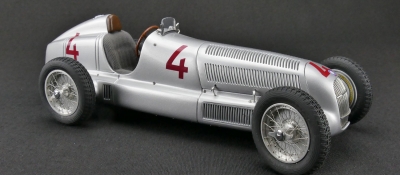CMC Alfa Romeo P3 Chiron, winner GP Marseille 1933, #42
Limited Edition 1,000 pcs.
The Alfa Romeo Tipo B was the most successful single-seater Grand Prix racing car of its time. Alfa Romeo built and raced it between 1932 and 1936. Initially as a factory race car for Alfa Romeo, then later under the Scuderia Ferrari label after having taken over Alfa Romeos racing activities. The car, designed by the legendary engineer Vittorio Jano, was based on the equally legendary Alfa Romeo 8C models. The P3 was Alfa Romeos second single-seater after the Tipo-A monoposto of 1931.
$ 660.00
HISTORY (ORIGINAL VEHICLE)
The Alfa Romeo Tipo B was a single-seater Grand Prix racing car built and raced by Alfa Romeo between 1932 and 1936. Designed by Vittorio Jano, the car was based on the Alfa Romeo 8C models. The P3 was Alfa Romeo’s second single-seater after the Tipo-A monoposto of1931.It took over some components of the earlier very successful Alfa Romeo P2, which led to the unofficial designation “P3” in the press and among motorsport enthusiasts. Thanks to the numerous victories achieved by Tazio Nuvolari and Achille Varzi, among others, it is considered one of the best competition cars ever built.
The chassis, with longitudinal spars and cross members in pressed steel C-sections, derived from that of the Tipo A, was adapted to the regulations and modified to accommodate the new engine. This version of the engine had a larger displacement of 2654 cc (bore × stroke: 65 × 100 mm) than the turbocharged inline eight-cylinder engine of the 8C 2300 “Monza”.It was advanced for its time, with a light-alloy cylinder block and head divided into two halves, each with four cylinders. Jano divided the block to reduce torsional vibration of the crankshaft and camshafts by placing all the power take-offs in the center of the crankshaft: driving the camshafts, on the side driving the supercharger fans, and opposite on the exhaust side driving the pumps for oil and cooling water. The crankcase was in one piece. The engine had dry sump lubrication, two Roots compressors and two Weber carburetors, magneto ignition and water cooling. It produced 215 hp at 5600 rpm.
The four-speed transmission and multi-plate clutch were interlocked with the engine.
Wheels were suspended front and rear on rigid axles with semi-elliptic leaf springs and friction shock absorbers, rear springs and dampers were double. The drum brakes were mechanically operated. A novelty of the Type B P3 was the placement of the differential immediately behind the manual transmission. From there, power was transmitted to the rear wheels via bevel gear pairs with two diagonally arranged shafts.The differential being located further forward reduced the unsprung masses and the load on the rear axle. This was intended to reduce the tendency to oversteer, and the driver’s seat could be mounted directly on the floor panel between these shafts in the interests of a low center of gravity.
This 700 kg single-seater with its simple, streamlined body reached 225 km/h.
In the very first race of the Tipo B/P3 on June 5, 1932, at the 10th Italian Grand Prix, Tazio Nuvolari won at Monza.The season continued with six more victories for Alfa Romeo, including the most important Grands Prix of the time, namely those of France and Germany (at the Nürburgring). The second driver was the German Rudolf Caracciola.Thanks to these successes, Alfa Romeo won the International Automobile Championship with Nuvolari, which in that year was based on the Grands Prix of Italy, France and Germany.
In 1933 the factory team “Alfa Romeo” was closed due to the financial problems of Alfa Romeo. Consequently, direct participation in competitions was suspended.All of Alfa Romeo’s racing equipment was transferred to Scuderia Ferrari in Modena, which had prepared and fielded the race cars since 1929. That year, the Tipo B did not participate in the first 25 competitions and did not compete again until August.It won six of the remaining eleven races, including the Italian and Spanish Grands Prix.
Legal Disclaimer
The use of manufacturers’ names, symbols, type designations, and/or descriptions is solely for reference purposes. It does not imply that the CMC scale model is a product of any of these manufacturers.
The use of racing term and/or driver names, symbols, starting numbers, and/or descriptions is solely for reference purposes. Unless otherwise stated, it does not imply that the CMC scale model is a product of any of these racing teams/drivers or endorsed by any of them.
Related products
Products
Made with Love
Links
Stay in Contact
Shop
You can contact us from Monday – Friday
between 9am to 5pm.







